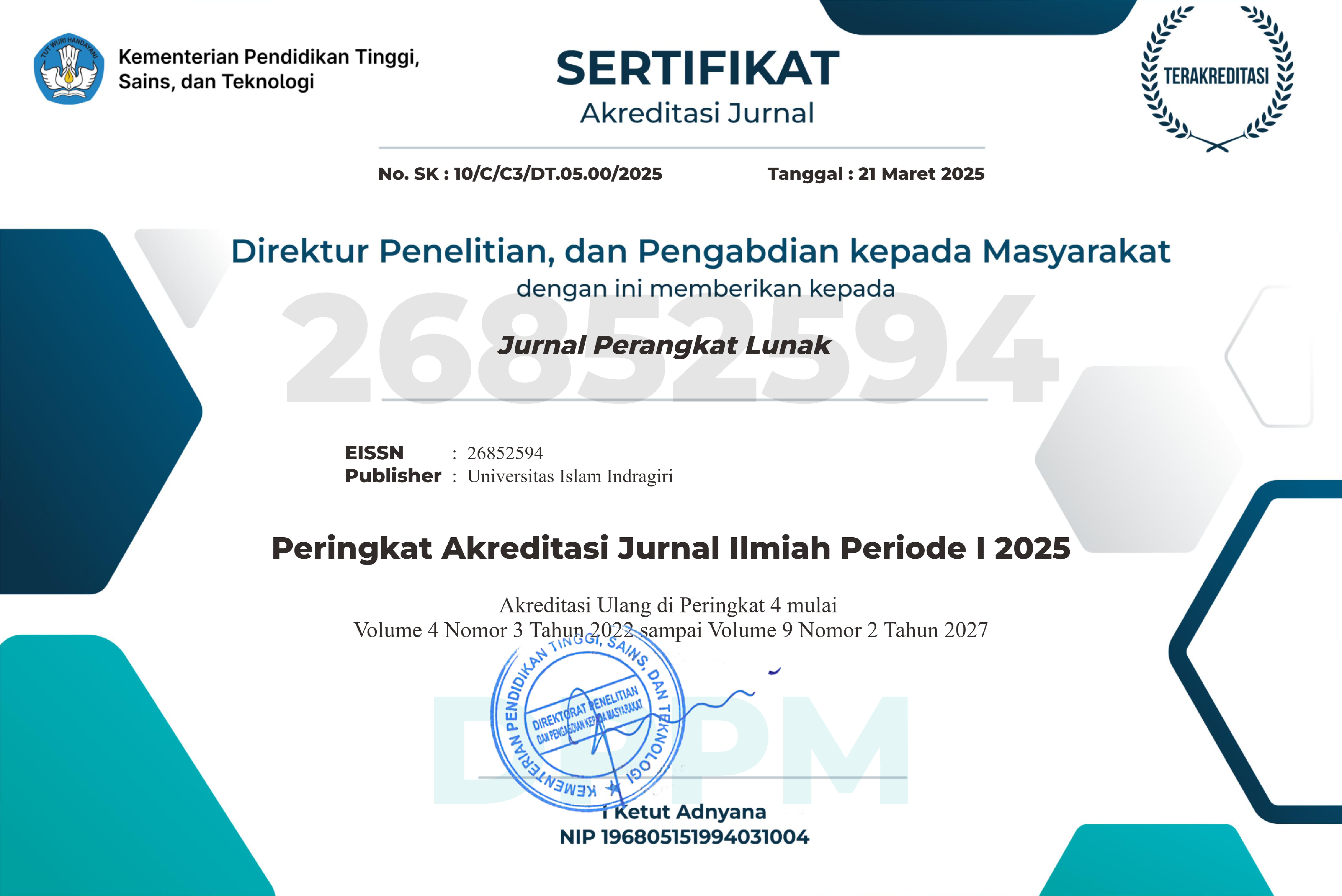PENILAIAN KINERJA KARYAWAN MENGGUNAKAN METODE HUMAN RESOURCES SCORECARD (HRSC) DAN ANALYTICHAL HIERARCHY PROCESS (AHP)
Abstract
Kinerja merupakan perilaku nyata yang telah dihasilkan setiap karyawan sebagai prestasi yang dihasilkan sesuai dengan tugasnnya dalam perusahaan. Untuk mengetahui kinerja karyawan disuatu perusahaan perlu adanya pengukuran kinerja. Pengukuran kinerja merupakan suatu tenant incubator bisnis.penelitian ini bertujuan untuk menganalisis penilaian kinerja di PT. XYZ yang berfokus pada bagian produksi. Metode yang digunakan adalah metode human resource scorecard (HRSC) dan analytichal hierarchy process (AHP). Perspektif yang paling tepat yang ditinjau dari penelitian ini adalah perspektif keuangan pada gaju dan bonus karyawan, perspektif pelangga pada peningkatan kepuasan pelanggan, perspektif proses bisnis internal pada peningkatan motivasi kerja karyawan, dan perspektif pertumbuhan dan pembelajaran pada peningkatan skill karyawan.
Downloads
References
[2] M. Khaleeli, “The effect of green marketing, green supply chain and green human resources on business performance: balanced scorecard approach,” Uncertain Supply Chain Manag., vol. 9, no. 1, pp. 133–138, 2021, doi: 10.5267/j.uscm.2020.11.001.
[3] E. Nafari, “Relationship between human resources strategies and organizational performance based on the balanced scorecard in a public hospital in Iran: a cross-sectional study,” BMC Health Serv. Res., vol. 22, no. 1, 2022, doi: 10.1186/s12913-022-07767-z.
[4] N. Alipour, “Investigating Green Human Resource Practices in the Healthcare Sector: A Joint Application of Balanced Scorecard and SIR Method,” Proceedings of 2019 15th Iran International Industrial Engineering Conference, IIIEC 2019. pp. 283–288, 2019. doi: 10.1109/IIIEC.2019.8720625.
[5] G. Filhaq, S. Aprianto, and H. Alfianto, “Design of Smart Locker Door Using Quality Function Deployment Based on ATMega 2560 Microcontroller,” J. Ris. Ilmu Tek., vol. 1, no. 1, pp. 25–35, 2023.
[6] F. Pohan, I. Saputra, and R. Tua, “Scheduling Preventive Maintenance to Determine Maintenance Actions on Screw Press Machine,” J. Ris. Ilmu Tek., vol. 1, no. 1, pp. 1–12, 2023.
[7] Ahmad, “Performance analysis of employees at Pt. Sungaiberkat serani sukses using human resource scorecard method,” IOP Conference Series: Materials Science and Engineering, vol. 852, no. 1. 2020. doi: 10.1088/1757-899X/852/1/012119.
[8] Amelia, “Analysis of human resources performance measurement by human resources scorecard method at hospital in Surabaya,” Indian J. Public Heal. Res. Dev., vol. 10, no. 6, pp. 391–397, 2019, doi: 10.5958/0976-5506.2019.01304.4.
[9] Y. Liu, “A review of fuzzy AHP methods for decision-making with subjective judgements,” Expert Systems with Applications, vol. 161. 2020. doi: 10.1016/j.eswa.2020.113738.
[10] V. C. Dewi, V. Amrizal, and F. E. M. Agustin, “Implementation of Adaptive Neuro-Fuzzy Inference System and Image Processing for Design Applications Paper Age Prediction,” J. Ris. Ilmu Tek., vol. 1, no. 1, pp. 45–57, 2023.
[11] S. Lohana, “Performance measurement of human resource by design a human resource scorecard,” Materials Today: Proceedings, vol. 51. pp. 677–681, 2021. doi: 10.1016/j.matpr.2021.06.203.
[12] T. M. Sari and W. Dini, “Risk Assessment and Mitigation Strategy in The Halal Broiler Supply Chain,” J. Ris. Ilmu Tek., vol. 1, no. 1, pp. 13–24, 2023.
[13] M. Mathew, “A novel approach integrating AHP and TOPSIS under spherical fuzzy sets for advanced manufacturing system selection,” Eng. Appl. Artif. Intell., vol. 96, 2020, doi: 10.1016/j.engappai.2020.103988.
[14] I. N. Permadi and D. B. Nisa, “A Model Experiment Design Using the Taguchi Method: A Case Study Of Making Concrete Roof,” J. Ris. Ilmu Tek., vol. 1, no. 1, pp. 36–44, 2023.
[15] Y. Wang, “Strategic renewable energy resources selection for Pakistan: Based on SWOT-Fuzzy AHP approach,” Sustain. Cities Soc., vol. 52, 2020, doi: 10.1016/j.scs.2019.101861.
[16] S. S. Lubis, “Identify Financial Ratios to Measure The Company’s Financial Performance,” J. Econ. Bus. Ind., vol. 1, no. 1, pp. 1–10, 2023.
[17] V. A. Kumar, “Identification of Groundwater Potential Zones Using RS, GIS and AHP Techniques: A Case Study in a Part of Deccan Volcanic Province (DVP), Maharashtra, India,” J. Indian Soc. Remote Sens., vol. 48, no. 3, pp. 497–511, 2020, doi: 10.1007/s12524-019-01086-3.
[18] H. E. Colak, “Optimal site selection for solar photovoltaic (PV) power plants using GIS and AHP: A case study of Malatya Province, Turkey,” Renew. Energy, vol. 149, pp. 565–576, 2020, doi: 10.1016/j.renene.2019.12.078.
[19] L. Li, “Digital Twin Driven Green Performance Evaluation Methodology of Intelligent Manufacturing: Hybrid Model Based on Fuzzy Rough-Sets AHP, Multistage Weight Synthesis, and PROMETHEE II,” Complexity, vol. 2020, 2020, doi: 10.1155/2020/3853925.
[20] Y. A. Solangi, “Assessing and overcoming the renewable energy barriers for sustainable development in Pakistan: An integrated AHP and fuzzy TOPSIS approach,” Renew. Energy, vol. 173, pp. 209–222, 2021, doi: 10.1016/j.renene.2021.03.141.
[21] D. Souissi, “GIS-based MCDM–AHP modeling for flood susceptibility mapping of arid areas, southeastern Tunisia,” Geocarto Int., vol. 35, no. 9, pp. 991–1017, 2020, doi: 10.1080/10106049.2019.1566405.
[22] C. Ren, “Integrated multi-objective stochastic fuzzy programming and AHP method for agricultural water and land optimization allocation under multiple uncertainties,” J. Clean. Prod., vol. 210, pp. 12–24, 2019, doi: 10.1016/j.jclepro.2018.10.348.
[23] A. Darko, “Review of application of analytic hierarchy process (AHP) in construction,” Int. J. Constr. Manag., vol. 19, no. 5, pp. 436–452, 2019, doi: 10.1080/15623599.2018.1452098.
[24] P. Arulbalaji, “GIS and AHP Techniques Based Delineation of Groundwater Potential Zones: a case study from Southern Western Ghats, India,” Sci. Rep., vol. 9, no. 1, 2019, doi: 10.1038/s41598-019-38567-x.
[25] Y. A. Solangi, “Evaluating the strategies for sustainable energy planning in Pakistan: An integrated SWOT-AHP and Fuzzy-TOPSIS approach,” J. Clean. Prod., vol. 236, 2019, doi: 10.1016/j.jclepro.2019.117655.
[26] H. M. Lyu, “Inundation risk assessment of metro system using AHP and TFN-AHP in Shenzhen,” Sustain. Cities Soc., vol. 56, 2020, doi: 10.1016/j.scs.2020.102103.
[27] H. M. Lyu, “Risk Assessment Using a New Consulting Process in Fuzzy AHP,” J. Constr. Eng. Manag., vol. 146, no. 3, 2020, doi: 10.1061/(ASCE)CO.1943-7862.0001757.
[28] A. Calabrese, “Integrating sustainability into strategic decision-making: A fuzzy AHP method for the selection of relevant sustainability issues,” Technol. Forecast. Soc. Change, vol. 139, pp. 155–168, 2019, doi: 10.1016/j.techfore.2018.11.005.
Copyright (c) 2023 Rahman Gustian Maulana, Nazaruddin Nazaruddin, Suherman Suherman, Muhammad Rizki, Muhammad Isnaini Hadiyul Umam

This work is licensed under a Creative Commons Attribution-ShareAlike 4.0 International License.












